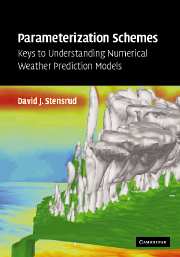Book contents
- Frontmatter
- Contents
- Preface
- List of principal symbols and abbreviations
- 1 Why study parameterization schemes?
- 2 Land surface–atmosphere parameterizations
- 3 Soil–vegetation–atmosphere parameterizations
- 4 Water–atmosphere parameterizations
- 5 Planetary boundary layer and turbulence parameterizations
- 6 Convective parameterizations
- 7 Microphysics parameterizations
- 8 Radiation parameterizations
- 9 Cloud cover and cloudy-sky radiation parameterizations
- 10 Orographic drag parameterizations
- 11 Thoughts on the future
- References
- Index
1 - Why study parameterization schemes?
Published online by Cambridge University Press: 05 September 2013
- Frontmatter
- Contents
- Preface
- List of principal symbols and abbreviations
- 1 Why study parameterization schemes?
- 2 Land surface–atmosphere parameterizations
- 3 Soil–vegetation–atmosphere parameterizations
- 4 Water–atmosphere parameterizations
- 5 Planetary boundary layer and turbulence parameterizations
- 6 Convective parameterizations
- 7 Microphysics parameterizations
- 8 Radiation parameterizations
- 9 Cloud cover and cloudy-sky radiation parameterizations
- 10 Orographic drag parameterizations
- 11 Thoughts on the future
- References
- Index
Summary
Introduction
The weather forecasts depicted in brilliant colors on television, in the newspapers, and on the Internet are providing ever greater details about how the atmosphere is going to evolve over the coming days and even the coming seasons. Both these details and the length of these predictions are due in large part to the increasing processing power of computers and the improving numerical weather prediction models that run on them. Numerical weather prediction models are computer software programs based upon the mathematical equations of motion describing the flow of fluids. Given the present state of the atmosphere, as estimated from weather observations across the globe, these models are able to move the atmosphere forward in time using a sequence of small steps and thereby predict a future state. Not only are these models a critical component in making weather forecasts for the coming week and season, but versions of these models are used to examine how increasing greenhouse gases influence future global climate. Thus, numerical models are important in making decisions not only about daily human activities but about how to be good stewards of planet Earth.
The initial models used for numerical weather prediction (NWP) were simplified versions of the complete equations of motion and were applied over relatively small portions of the globe. In 1949, Charney, Fjørtoft, and von Neumann produced the first one-day weather forecast using a one-layer barotropic model (Charney et al. 1950).
- Type
- Chapter
- Information
- Parameterization SchemesKeys to Understanding Numerical Weather Prediction Models, pp. 1 - 11Publisher: Cambridge University PressPrint publication year: 2007



